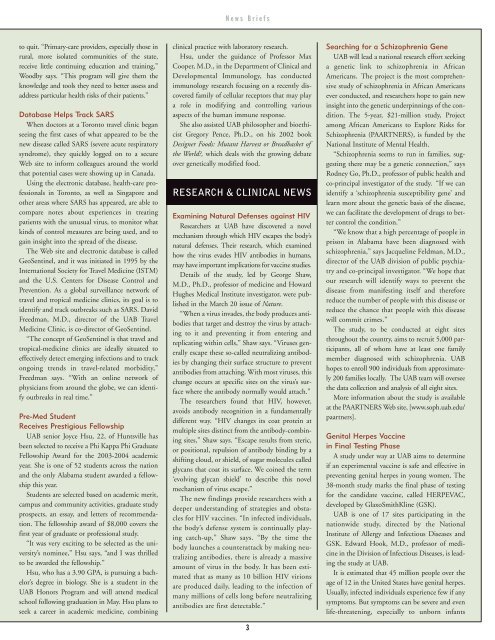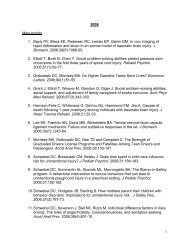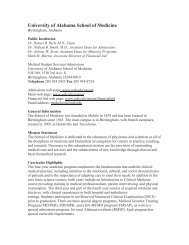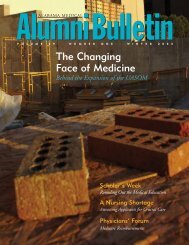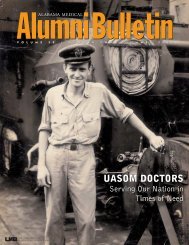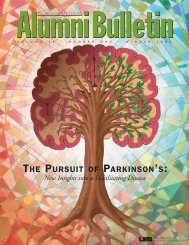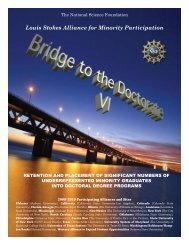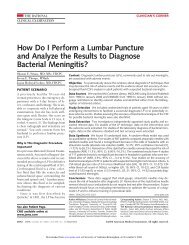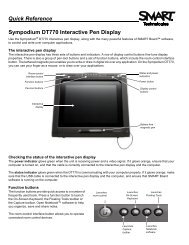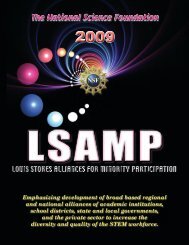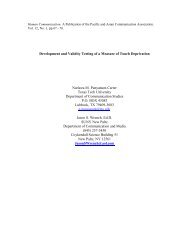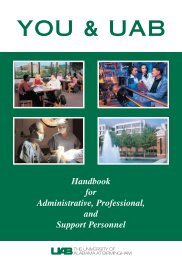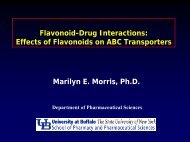AlumniBulletin - The University of Alabama at Birmingham
AlumniBulletin - The University of Alabama at Birmingham
AlumniBulletin - The University of Alabama at Birmingham
You also want an ePaper? Increase the reach of your titles
YUMPU automatically turns print PDFs into web optimized ePapers that Google loves.
News Briefs<br />
to quit. “Primary-care providers, especially those in<br />
rural, more isol<strong>at</strong>ed communities <strong>of</strong> the st<strong>at</strong>e,<br />
receive little continuing educ<strong>at</strong>ion and training,”<br />
Woodby says. “This program will give them the<br />
knowledge and tools they need to better assess and<br />
address particular health risks <strong>of</strong> their p<strong>at</strong>ients.”<br />
D<strong>at</strong>abase Helps Track SARS<br />
When doctors <strong>at</strong> a Toronto travel clinic began<br />
seeing the first cases <strong>of</strong> wh<strong>at</strong> appeared to be the<br />
new disease called SARS (severe acute respir<strong>at</strong>ory<br />
syndrome), they quickly logged on to a secure<br />
Web site to inform colleagues around the world<br />
th<strong>at</strong> potential cases were showing up in Canada.<br />
Using the electronic d<strong>at</strong>abase, health-care pr<strong>of</strong>essionals<br />
in Toronto, as well as Singapore and<br />
other areas where SARS has appeared, are able to<br />
compare notes about experiences in tre<strong>at</strong>ing<br />
p<strong>at</strong>ients with the unusual virus, to monitor wh<strong>at</strong><br />
kinds <strong>of</strong> control measures are being used, and to<br />
gain insight into the spread <strong>of</strong> the disease.<br />
<strong>The</strong> Web site and electronic d<strong>at</strong>abase is called<br />
GeoSentinel, and it was initi<strong>at</strong>ed in 1995 by the<br />
Intern<strong>at</strong>ional Society for Travel Medicine (ISTM)<br />
and the U.S. Centers for Disease Control and<br />
Prevention. As a global surveillance network <strong>of</strong><br />
travel and tropical medicine clinics, its goal is to<br />
identify and track outbreaks such as SARS. David<br />
Freedman, M.D., director <strong>of</strong> the UAB Travel<br />
Medicine Clinic, is co-director <strong>of</strong> GeoSentinel.<br />
“<strong>The</strong> concept <strong>of</strong> GeoSentinel is th<strong>at</strong> travel and<br />
tropical-medicine clinics are ideally situ<strong>at</strong>ed to<br />
effectively detect emerging infections and to track<br />
ongoing trends in travel-rel<strong>at</strong>ed morbidity,”<br />
Freedman says. “With an online network <strong>of</strong><br />
physicians from around the globe, we can identify<br />
outbreaks in real time.”<br />
Pre-Med Student<br />
Receives Prestigious Fellowship<br />
UAB senior Joyce Hsu, 22, <strong>of</strong> Huntsville has<br />
been selected to receive a Phi Kappa Phi Gradu<strong>at</strong>e<br />
Fellowship Award for the 2003-2004 academic<br />
year. She is one <strong>of</strong> 52 students across the n<strong>at</strong>ion<br />
and the only <strong>Alabama</strong> student awarded a fellowship<br />
this year.<br />
Students are selected based on academic merit,<br />
campus and community activities, gradu<strong>at</strong>e study<br />
prospects, an essay, and letters <strong>of</strong> recommend<strong>at</strong>ion.<br />
<strong>The</strong> fellowship award <strong>of</strong> $8,000 covers the<br />
first year <strong>of</strong> gradu<strong>at</strong>e or pr<strong>of</strong>essional study.<br />
“It was very exciting to be selected as the university’s<br />
nominee,” Hsu says, “and I was thrilled<br />
to be awarded the fellowship.”<br />
Hsu, who has a 3.90 GPA, is pursuing a bachelor’s<br />
degree in biology. She is a student in the<br />
UAB Honors Program and will <strong>at</strong>tend medical<br />
school following gradu<strong>at</strong>ion in May. Hsu plans to<br />
seek a career in academic medicine, combining<br />
clinical practice with labor<strong>at</strong>ory research.<br />
Hsu, under the guidance <strong>of</strong> Pr<strong>of</strong>essor Max<br />
Cooper, M.D., in the Department <strong>of</strong> Clinical and<br />
Developmental Immunology, has conducted<br />
immunology research focusing on a recently discovered<br />
family <strong>of</strong> cellular receptors th<strong>at</strong> may play<br />
a role in modifying and controlling various<br />
aspects <strong>of</strong> the human immune response.<br />
She also assisted UAB philosopher and bioethicist<br />
Gregory Pence, Ph.D., on his 2002 book<br />
Designer Foods: Mutant Harvest or Breadbasket <strong>of</strong><br />
the World?, which deals with the growing deb<strong>at</strong>e<br />
over genetically modified food.<br />
RESEARCH & CLINICAL NEWS<br />
Examining N<strong>at</strong>ural Defenses against HIV<br />
Researchers <strong>at</strong> UAB have discovered a novel<br />
mechanism through which HIV escapes the body’s<br />
n<strong>at</strong>ural defenses. <strong>The</strong>ir research, which examined<br />
how the virus evades HIV antibodies in humans,<br />
may have important implic<strong>at</strong>ions for vaccine studies.<br />
Details <strong>of</strong> the study, led by George Shaw,<br />
M.D., Ph.D., pr<strong>of</strong>essor <strong>of</strong> medicine and Howard<br />
Hughes Medical Institute investig<strong>at</strong>or, were published<br />
in the March 20 issue <strong>of</strong> N<strong>at</strong>ure.<br />
“When a virus invades, the body produces antibodies<br />
th<strong>at</strong> target and destroy the virus by <strong>at</strong>taching<br />
to it and preventing it from entering and<br />
replic<strong>at</strong>ing within cells,” Shaw says. “Viruses generally<br />
escape these so-called neutralizing antibodies<br />
by changing their surface structure to prevent<br />
antibodies from <strong>at</strong>taching. With most viruses, this<br />
change occurs <strong>at</strong> specific sites on the virus’s surface<br />
where the antibody normally would <strong>at</strong>tach.”<br />
<strong>The</strong> researchers found th<strong>at</strong> HIV, however,<br />
avoids antibody recognition in a fundamentally<br />
different way. “HIV changes its co<strong>at</strong> protein <strong>at</strong><br />
multiple sites distinct from the antibody-combining<br />
sites,” Shaw says. “Escape results from steric,<br />
or positional, repulsion <strong>of</strong> antibody binding by a<br />
shifting cloud, or shield, <strong>of</strong> sugar molecules called<br />
glycans th<strong>at</strong> co<strong>at</strong> its surface. We coined the term<br />
‘evolving glycan shield’ to describe this novel<br />
mechanism <strong>of</strong> virus escape.”<br />
<strong>The</strong> new findings provide researchers with a<br />
deeper understanding <strong>of</strong> str<strong>at</strong>egies and obstacles<br />
for HIV vaccines. “In infected individuals,<br />
the body’s defense system is continually playing<br />
c<strong>at</strong>ch-up,” Shaw says. “By the time the<br />
body launches a counter<strong>at</strong>tack by making neutralizing<br />
antibodies, there is already a massive<br />
amount <strong>of</strong> virus in the body. It has been estim<strong>at</strong>ed<br />
th<strong>at</strong> as many as 10 billion HIV virions<br />
are produced daily, leading to the infection <strong>of</strong><br />
many millions <strong>of</strong> cells long before neutralizing<br />
antibodies are first detectable.”<br />
3<br />
Searching for a Schizophrenia Gene<br />
UAB will lead a n<strong>at</strong>ional research effort seeking<br />
a genetic link to schizophrenia in African<br />
Americans. <strong>The</strong> project is the most comprehensive<br />
study <strong>of</strong> schizophrenia in African Americans<br />
ever conducted, and researchers hope to gain new<br />
insight into the genetic underpinnings <strong>of</strong> the condition.<br />
<strong>The</strong> 5-year, $21-million study, Project<br />
among African Americans to Explore Risks for<br />
Schizophrenia (PAARTNERS), is funded by the<br />
N<strong>at</strong>ional Institute <strong>of</strong> Mental Health.<br />
“Schizophrenia seems to run in families, suggesting<br />
there may be a genetic connection,” says<br />
Rodney Go, Ph.D., pr<strong>of</strong>essor <strong>of</strong> public health and<br />
co-principal investig<strong>at</strong>or <strong>of</strong> the study. “If we can<br />
identify a ‘schizophrenia susceptibility gene’ and<br />
learn more about the genetic basis <strong>of</strong> the disease,<br />
we can facilit<strong>at</strong>e the development <strong>of</strong> drugs to better<br />
control the condition.”<br />
“We know th<strong>at</strong> a high percentage <strong>of</strong> people in<br />
prison in <strong>Alabama</strong> have been diagnosed with<br />
schizophrenia,” says Jacqueline Feldman, M.D.,<br />
director <strong>of</strong> the UAB division <strong>of</strong> public psychi<strong>at</strong>ry<br />
and co-principal investig<strong>at</strong>or. “We hope th<strong>at</strong><br />
our research will identify ways to prevent the<br />
disease from manifesting itself and therefore<br />
reduce the number <strong>of</strong> people with this disease or<br />
reduce the chance th<strong>at</strong> people with this disease<br />
will commit crimes.”<br />
<strong>The</strong> study, to be conducted <strong>at</strong> eight sites<br />
throughout the country, aims to recruit 5,000 participants,<br />
all <strong>of</strong> whom have <strong>at</strong> least one family<br />
member diagnosed with schizophrenia. UAB<br />
hopes to enroll 900 individuals from approxim<strong>at</strong>ely<br />
200 families locally. <strong>The</strong> UAB team will oversee<br />
the d<strong>at</strong>a collection and analysis <strong>of</strong> all eight sites.<br />
More inform<strong>at</strong>ion about the study is available<br />
<strong>at</strong> the PAARTNERS Web site, [www.soph.uab.edu/<br />
paartners].<br />
Genital Herpes Vaccine<br />
in Final Testing Phase<br />
A study under way <strong>at</strong> UAB aims to determine<br />
if an experimental vaccine is safe and effective in<br />
preventing genital herpes in young women. <strong>The</strong><br />
38-month study marks the final phase <strong>of</strong> testing<br />
for the candid<strong>at</strong>e vaccine, called HERPEVAC,<br />
developed by GlaxoSmithKline (GSK).<br />
UAB is one <strong>of</strong> 17 sites particip<strong>at</strong>ing in the<br />
n<strong>at</strong>ionwide study, directed by the N<strong>at</strong>ional<br />
Institute <strong>of</strong> Allergy and Infectious Diseases and<br />
GSK. Edward Hook, M.D., pr<strong>of</strong>essor <strong>of</strong> medicine<br />
in the Division <strong>of</strong> Infectious Diseases, is leading<br />
the study <strong>at</strong> UAB.<br />
It is estim<strong>at</strong>ed th<strong>at</strong> 45 million people over the<br />
age <strong>of</strong> 12 in the United St<strong>at</strong>es have genital herpes.<br />
Usually, infected individuals experience few if any<br />
symptoms. But symptoms can be severe and even<br />
life-thre<strong>at</strong>ening, especially to unborn infants


